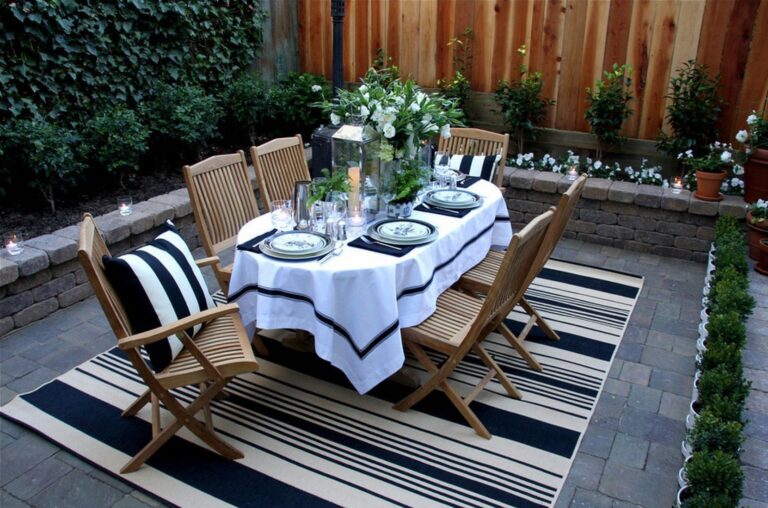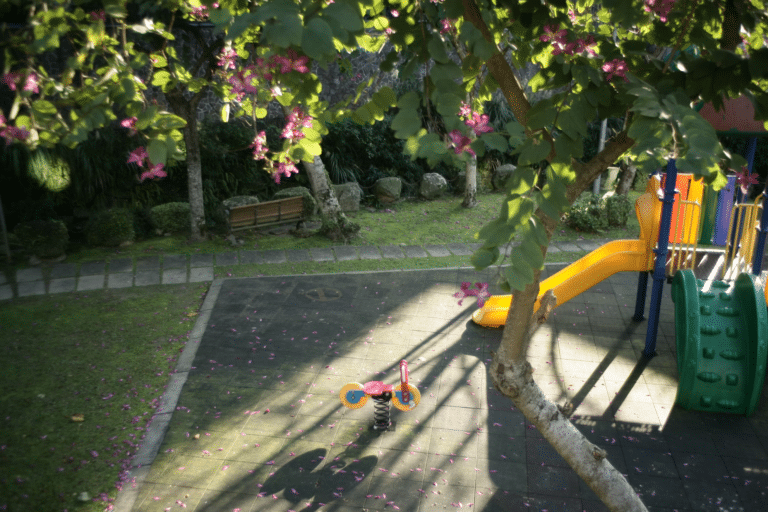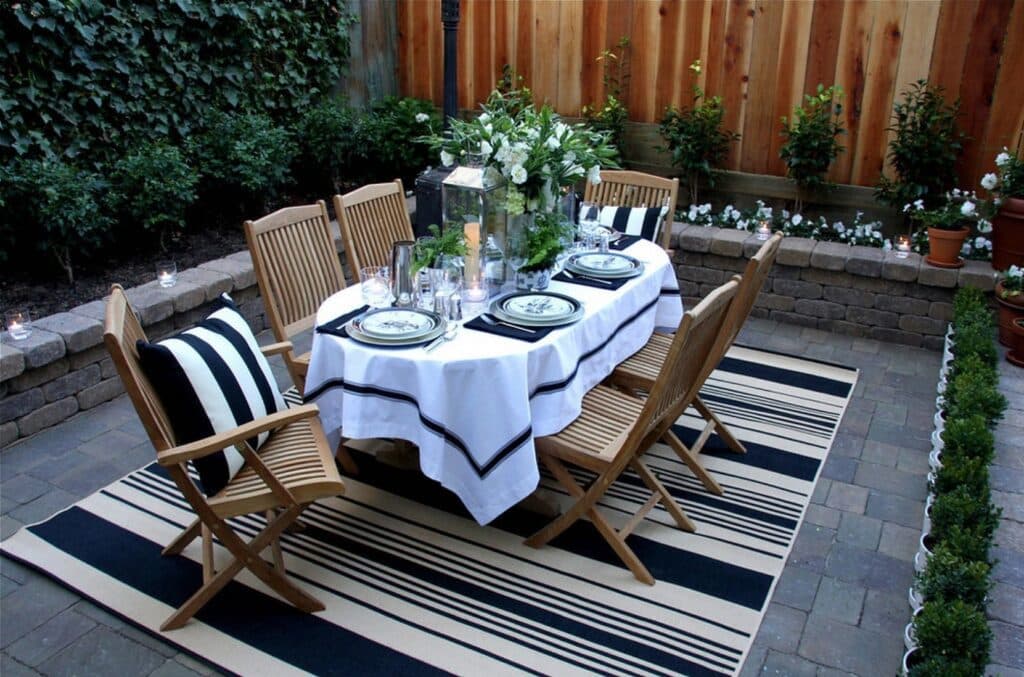Finding the right flowers for a garden can be tough. Gardeners browse catalogs and visit nurseries but still feel unsure about what to plant.
Many people struggle with the countless options without a clear starting point.
But what if this process could be simplified? By focusing on flowers that start with the A, gardeners can narrow their choices while still enjoying plenty of variety and beauty in their outdoor spaces.
This blog post will walk readers through some wonderful A-named flowers that can add color and charm to gardens.
From tiny annuals to tall perennials, these plants offer something for every gardener. These often-overlooked blooms might become new favorites in anyone’s garden.
Bewitching Flowers That Start With A
1. Ageratum
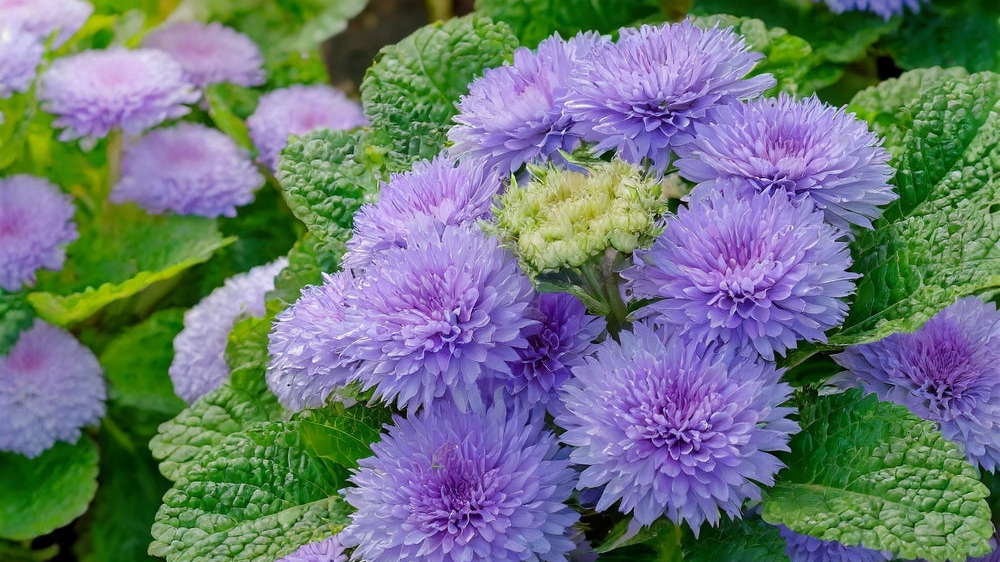
Ageratum is a charming annual flower known for its fluffy, button-like blooms that come in shades of blue, pink, and white.
Native to Central America, it’s a popular border plant thanks to its compact growth and vibrant color. Gardeners love its long blooming season, which extends from late spring into fall.
Ageratum lives in full sun and well-drained soil, making it a low-maintenance choice for flower beds.
It’s also deer-resistant and attracts pollinators like bees and butterflies. Because of its dense clusters, it’s often used in cottage-style or cutting gardens. Deadheading spent flowers encourages more blooms throughout the season.
| Category | Details |
|---|---|
| Scientific Name | Ageratum houstonianum |
| Commonly Found Region | Central America |
| Blooming Period | Late spring to fall |
| Symbolism | Patience, dignity, and lasting love |
| Benefits | Attracts pollinators, deer-resistant, long bloom season |
2. Alyssum
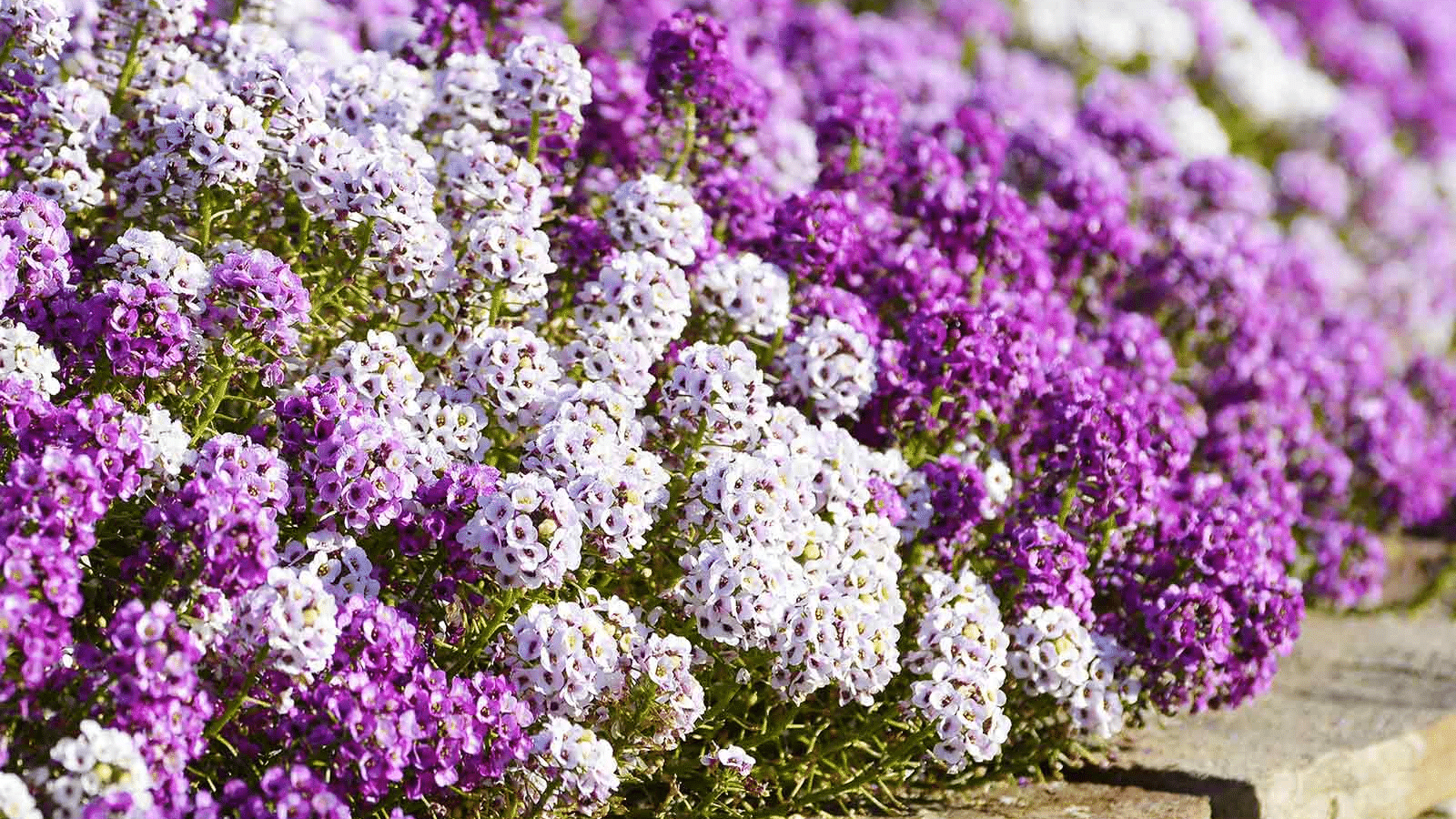
Alyssum, often called sweet alyssum, is a very soft and fragrant annual that produces tiny clusters of white, pink, or purple flowers.
Due to its spreading habit and low-growing nature, it’s ideal for ground cover, hanging baskets, or edging borders.
The blooms are honey-scented, attracting bees and beneficial insects throughout the growing season. It survives in cool weather and can tolerate poor soil conditions, making it great for rock gardens. Gardeners appreciate alyssum for its resilience and ease of care.
It also readily reseeds, often returning year after year in mild climates. This plant lives in full sun or partial shade.
| Category | Details |
|---|---|
| Scientific Name | Lobularia maritima |
| Commonly Found Region | Mediterranean, global garden use |
| Blooming Period | Spring to fall |
| Symbolism | Worth beyond beauty, sweetness |
| Benefits | Ground cover, attracts pollinators, easy care |
3. Aster
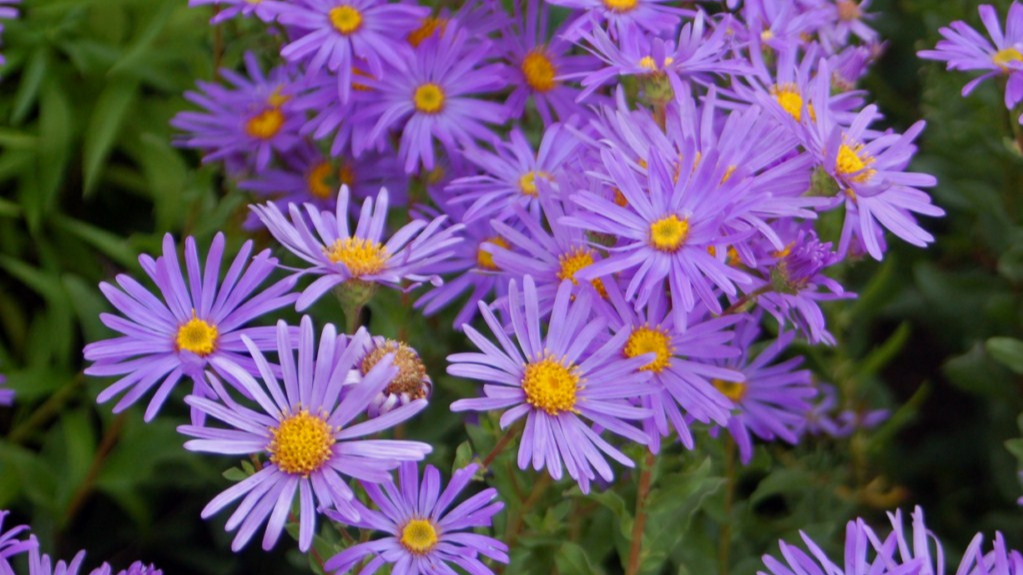
Asters are daisy-like perennials that bloom in late summer to fall, bringing vibrant purple, pink, blue, and white tones to the garden.
They’re loved for their star-shaped flowers and ability to attract bees and butterflies, especially monarchs during migration.
Asters live in full sun and well-draining soil, though some varieties can tolerate partial shade. Their tall, upright habit makes them perfect for borders and wildflower gardens. They’re commonly planted with ornamental grasses for a graceful fall display.
Regular division helps maintain plant health and encourages prolific flowering year after year. They also make excellent cut flowers.
| Category | Details |
|---|---|
| Scientific Name | Aster spp. |
| Commonly Found Region | North America, Europe, Asia |
| Blooming Period | Late summer to fall |
| Symbolism | Love, wisdom, and faith |
| Benefits | Attracts monarchs, excellent for borders, cut flower |
4. Azalea
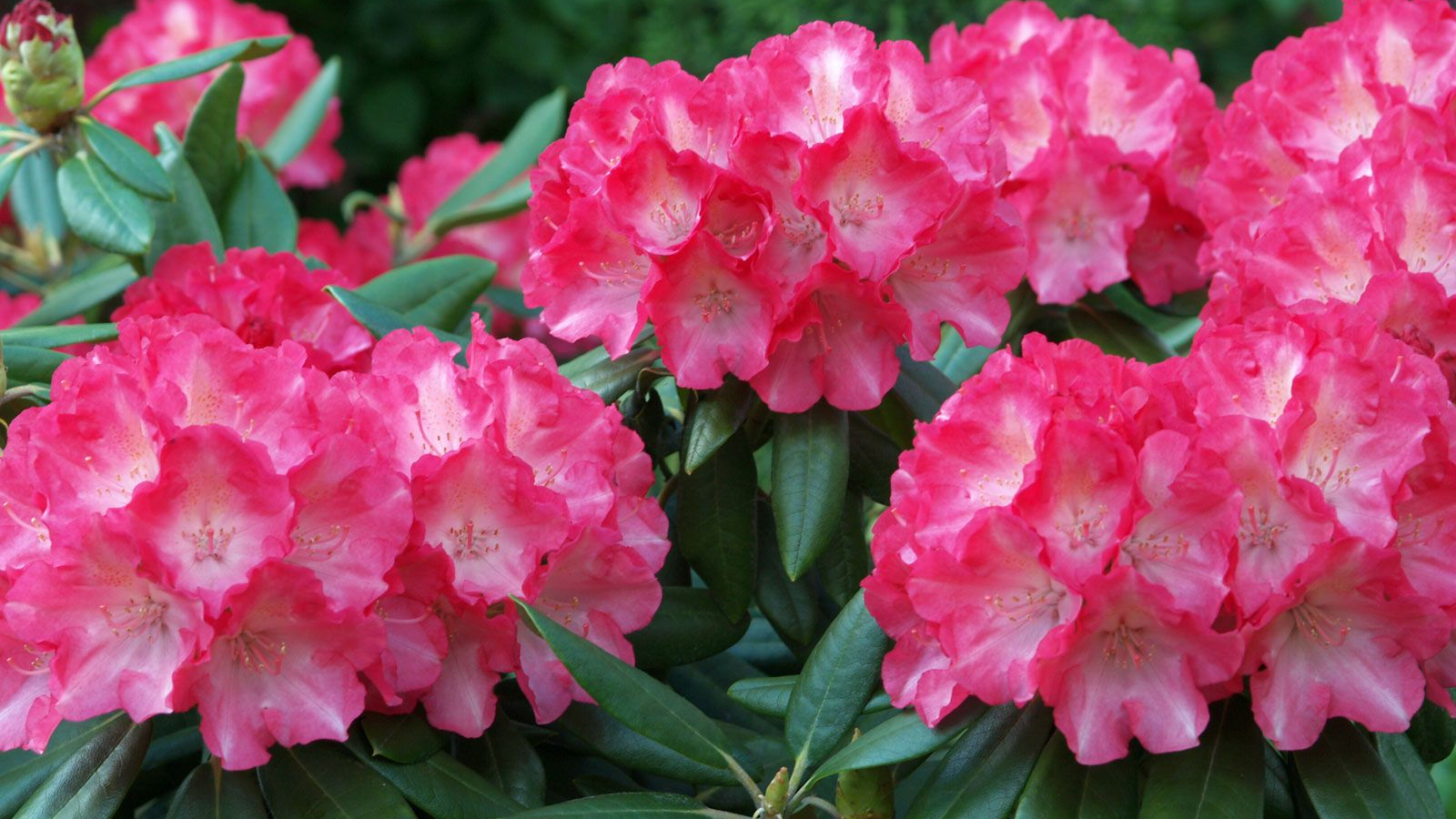
Azaleas are stunning flowering shrubs known for their dramatic spring blooms in shades of pink, red, purple, and white. Part of the rhododendron family, these plants are shade-tolerant and prefer acidic, well-drained soil.
They’re widely used in foundation plantings, woodland gardens, and as specimen plants for seasonal interest.
Azaleas range from low-growing ground covers to larger shrubs, offering versatility in landscape design. Their funnel-shaped flowers can last several weeks and often attract hummingbirds.
Proper pruning after blooming encourages dense growth. Mulching helps keep roots cool and moist, supporting healthier and more vibrant blooms each year.
| Category | Details |
|---|---|
| Scientific Name | Rhododendron spp. |
| Commonly Found Region | Asia, North America |
| Blooming Period | Spring |
| Symbolism | Abundance, grace, femininity |
| Benefits | Shade-tolerant, attracts hummingbirds, seasonal interest |
5. Amaryllis
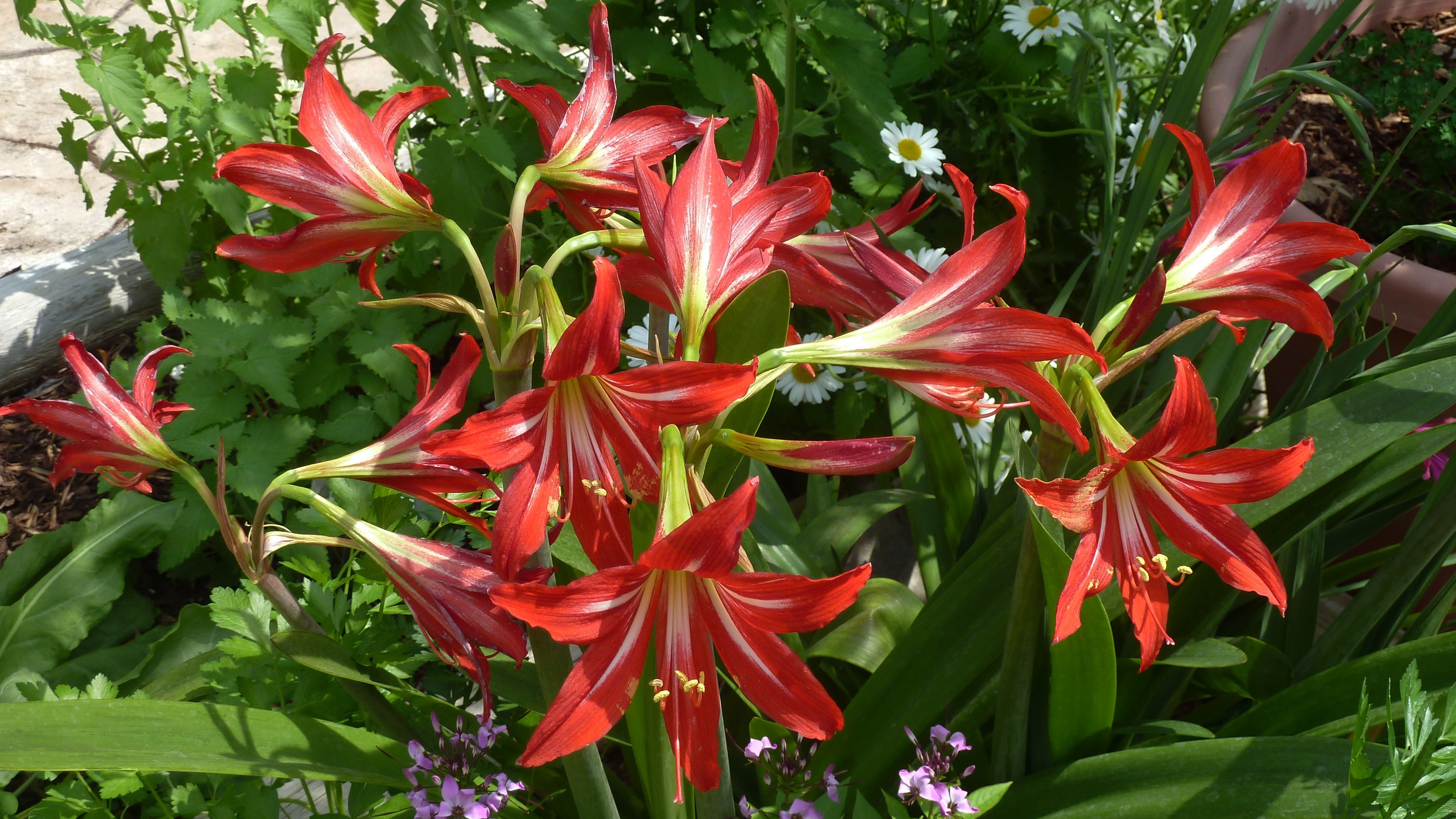
Amaryllis is a bold, trumpet-shaped flower often grown indoors during winter for its striking beauty and festive presence.
They typically bloom in red, pink, white, or bi-color hues, standing tall on leafless stalks. The bulbs are easy to grow and can be forced to flower indoors with minimal effort.
Once established, they may rebloom annually with proper care. Outdoors, they live in warm climates with full sun to partial shade. After blooming, the foliage supports bulb development for future flowers.
Their showy appearance makes them a favorite for holiday gifts and decorative displays.
| Category | Details |
|---|---|
| Scientific Name | Hippeastrum spp. |
| Commonly Found Region | South America |
| Blooming Period | Winter (indoors), spring (outdoors) |
| Symbolism | self-esteem, strength, and beauty |
| Benefits | Indoor bloom, long-lasting, easy to grow from bulbs |
6. Alstroemeria
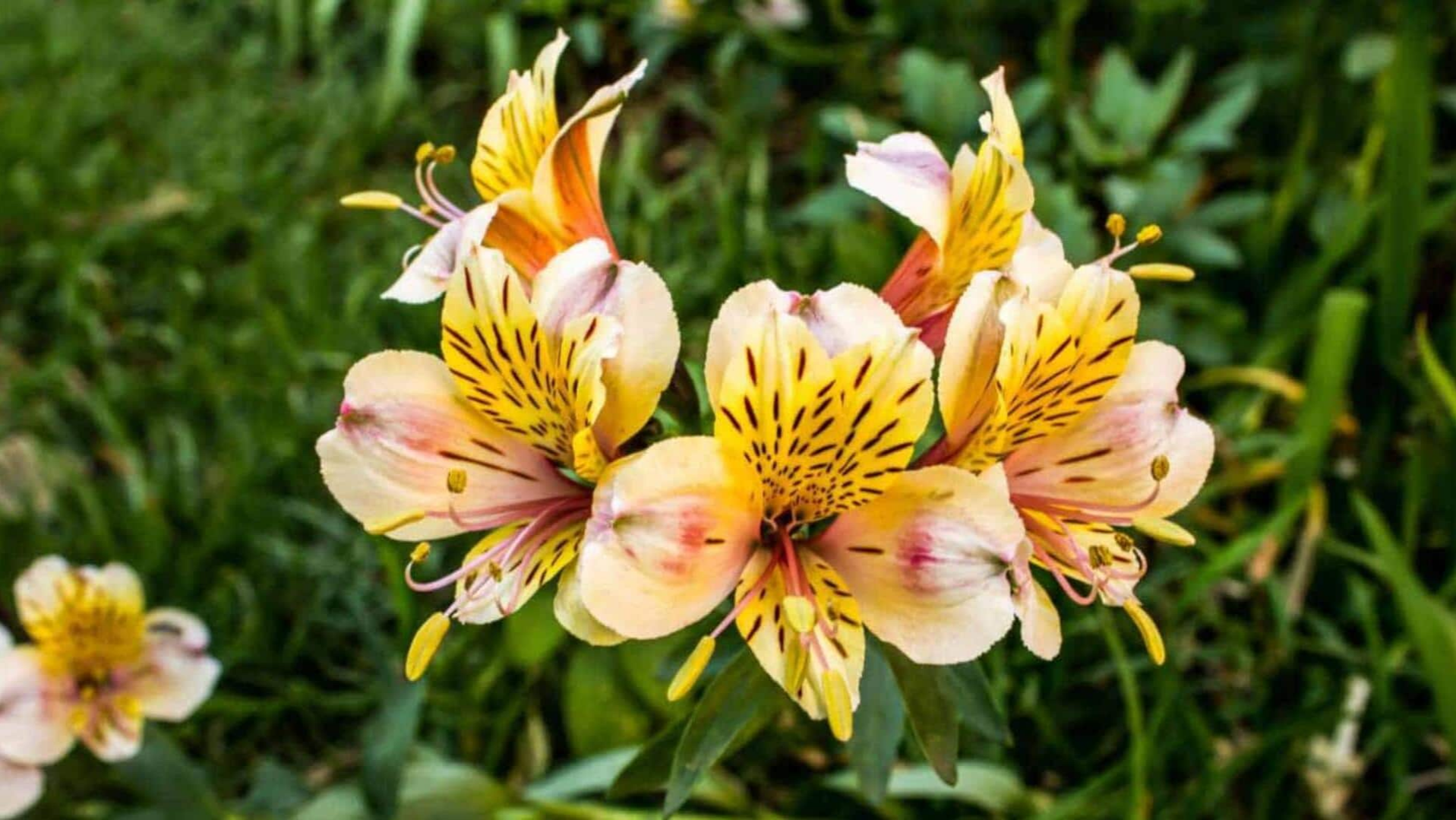
Alstroemeria, also known as Peruvian lily or lily of the Incas, is a popular cut flower admired for its vibrant petals and long vase life.
The blooms come in a wide range of colors, including orange, pink, red, and purple, often with striking streaks or spots.
Alstroemeria lives in cool climates and performs best in rich, well-drained soil with partial sun. It forms dense clumps and blooms prolifically from late spring to summer.
Though it may look very soft, it’s surprisingly hardy and drought-tolerant once established. Ideal for borders and bouquets, it symbolizes friendship and mutual support.
| Category | Details |
|---|---|
| Scientific Name | Alstroemeria spp. |
| Commonly Found Region | South America |
| Blooming Period | Late spring to summer |
| Symbolism | Friendship and mutual support |
| Benefits | Long vase life, drought-tolerant, vibrant colors |
7. Anemone
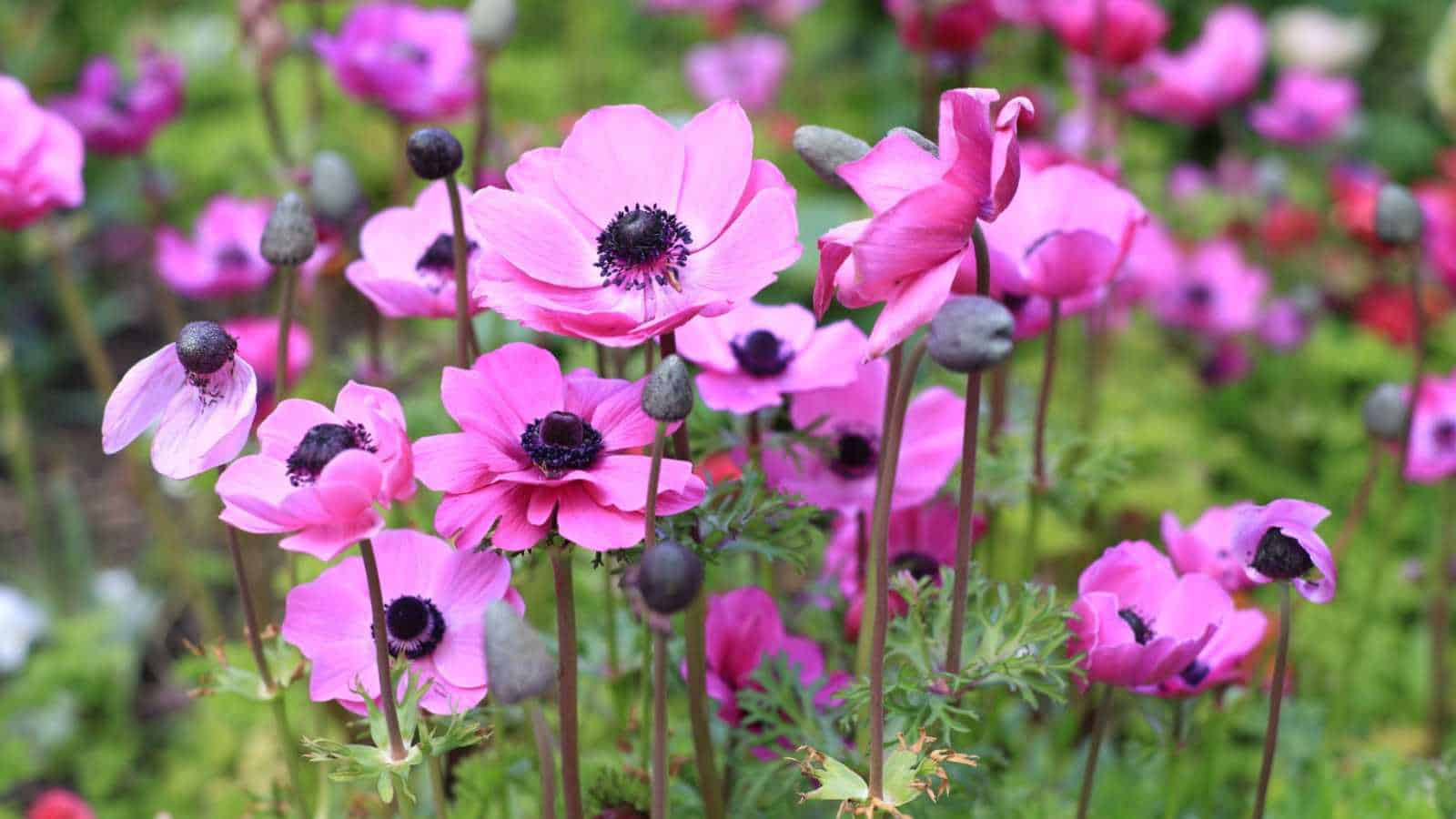
Anemones are smooth flowers that bloom in spring and fall. Their very soft petals and bold centers often recognize them.
Colors range from dark purples and reds to soft pastels and whites, making them stand out in floral arrangements. They prefer well-draining soil and full to partial sun, depending on the species.
Anemones are often used in woodland gardens or cottage-style settings where they can naturalize easily. They’re deer-resistant and attract pollinators during their blooming seasons. In folklore, these flowers symbolize anticipation and are associated with both love and protection.
| Category | Details |
|---|---|
| Scientific Name | Anemone spp. |
| Commonly Found Region | Europe, Asia, North America |
| Blooming Period | Spring or fall |
| Symbolism | Anticipation, love, and protection |
| Benefits | Deer-resistant, attracts pollinators, smooth appearance |
8. Angelonia
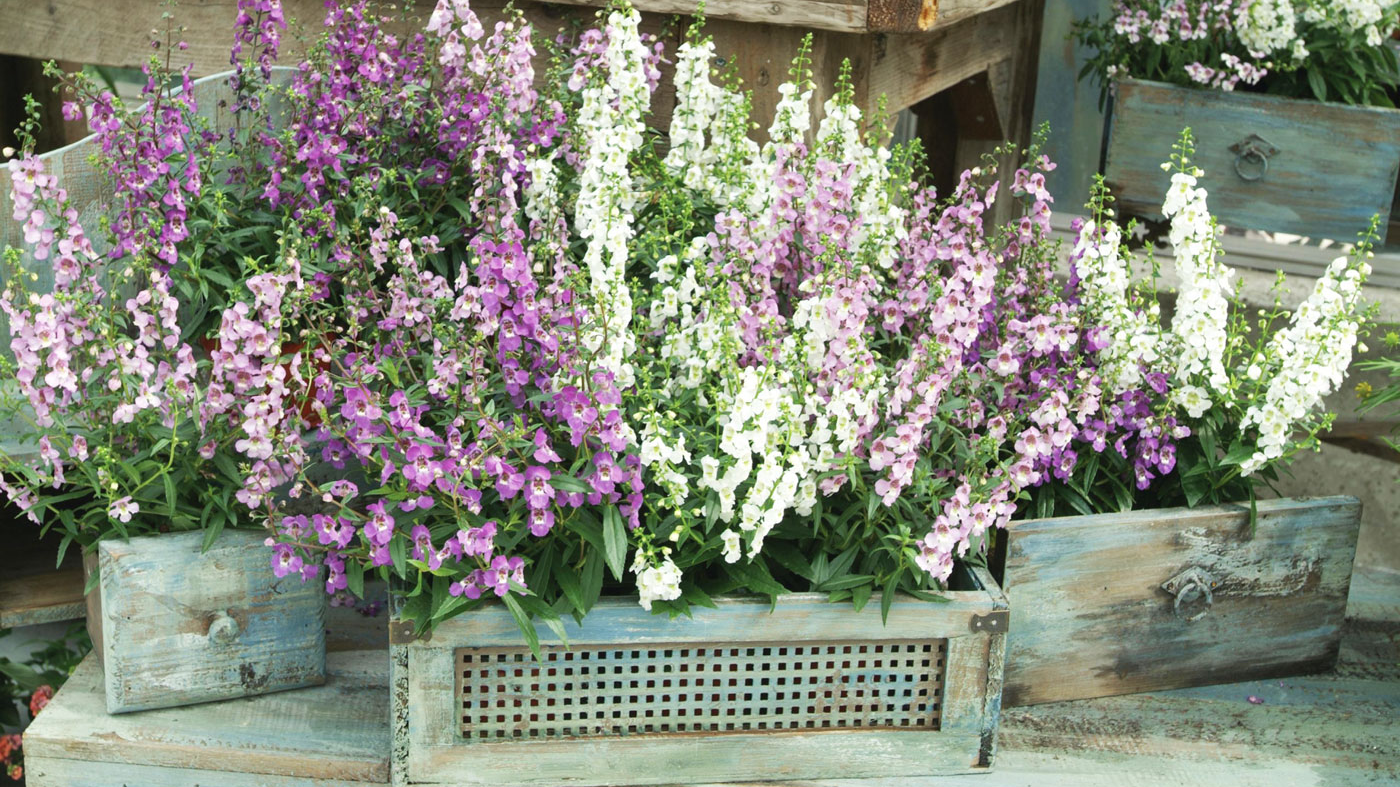
Angelonia, commonly known as summer snapdragon, is a heat-loving annual known for its spiked flowers and continuous bloom through hot months. It produces purple, pink, white, or blue blossoms that resemble miniature orchids and attract bees and butterflies.
Angelonia Survive in full sun and tolerates drought well, making it ideal for low-maintenance gardens. Its upright habit makes it perfect for borders and containers. This flower is often praised for its resistance to pests and diseases.
Gardeners value its extended bloom period and ability to add vertical interest to landscapes without much fuss.
| Category | Details |
|---|---|
| Scientific Name | Angelonia angustifolia |
| Commonly Found Region | Mexico, West Indies, South America |
| Blooming Period | Summer to fall |
| Symbolism | Joy and serenity |
| Benefits | Heat-tolerant, attracts pollinators, pest-resistant |
9. Allium
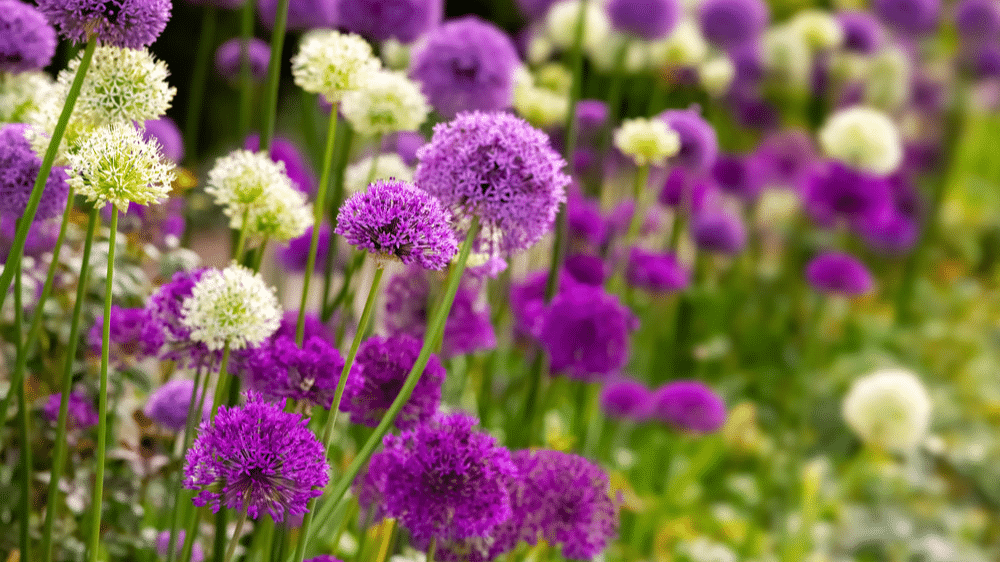
Alliums are ornamental onions known for their globe-shaped clusters of tiny star-like flowers perched atop tall, leafless stems.
These unique blooms come in purples, pinks, whites, and even yellows, creating bold focal points in spring and early summer gardens. Alliums live in full sun and well-drained soil, and they are remarkably deer- and rodent-resistant.
Their striking structural form makes them ideal for modern and formal landscapes. Once the blooms fade, their seed heads offer continued interest.
They also attract pollinators and are easy to grow from bulbs, which naturalize well over time.
| Category | Details |
|---|---|
| Scientific Name | Allium spp. |
| Commonly Found Region | Northern Hemisphere |
| Blooming Period | Late spring to early summer |
| Symbolism | Unity, prosperity, and patience |
| Benefits | Deer-resistant, bold design element attracts pollinators |
10. Anthurium
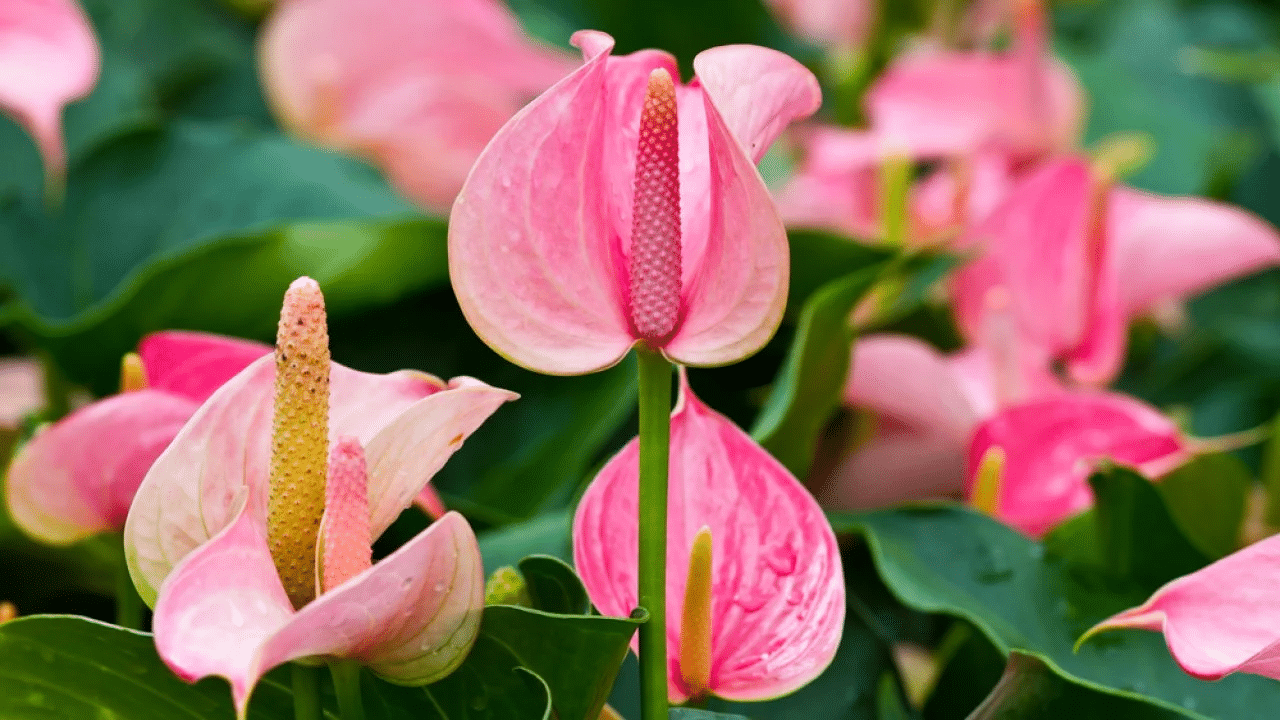
Anthuriums are tropical flowering plants known for their glossy, heart-shaped spathes and contrasting spadices in evocative reds, pinks, whites, and greens. Often grown indoors, they live in bright, indirect light and high humidity.
Their flowers can last several weeks, making them ideal for long-lasting arrangements.
In tropical climates, they can also be grown outdoors in shaded garden beds.
Anthuriums symbolize hospitality and abundance, and they are often used in home décor and gifting. They require minimal care beyond consistent moisture and occasional fertilizing.
Their bold appearance makes them popular in modern and minimalist designs.
| Category | Details |
|---|---|
| Scientific Name | Anthurium andraeanum |
| Commonly Found Region | Tropical America |
| Blooming Period | Year-round (indoors) |
| Symbolism | Hospitality and abundance |
| Benefits | Long-lasting blooms, indoor décor, low maintenance |
11. Arum Lily
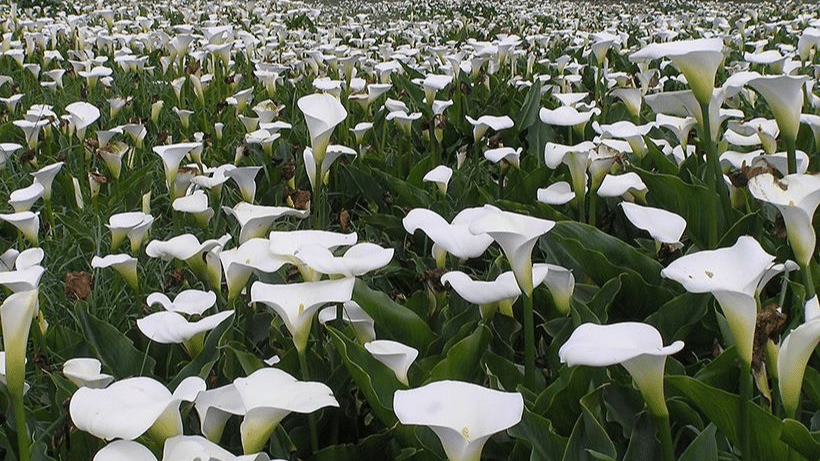
Arum lily, commonly referred to as calla lily, is known for its sleek, trumpet-shaped blooms and smooth appearance. Typically seen in white, it also comes in shades of purple, pink, and yellow, adding urbanity to floral arrangements and gardens.
It lives in moist, well-drained soil and can grow in full sun to partial shade, depending on the climate. Arum lilies are often associated with purity, rebirth, and sympathy, making them popular in weddings and funerals alike.
While beautiful, they are toxic if ingested and should be kept away from pets and children. They’re suitable for both containers and garden beds.
| Category | Details |
|---|---|
| Scientific Name | Zantedeschia aethiopica |
| Commonly Found Region | Southern Africa |
| Blooming Period | Late spring to summer |
| Symbolism | Purity, sympathy, rebirth |
| Benefits | Ornamental, suitable for containers, deer-resistant |
12. African Violet
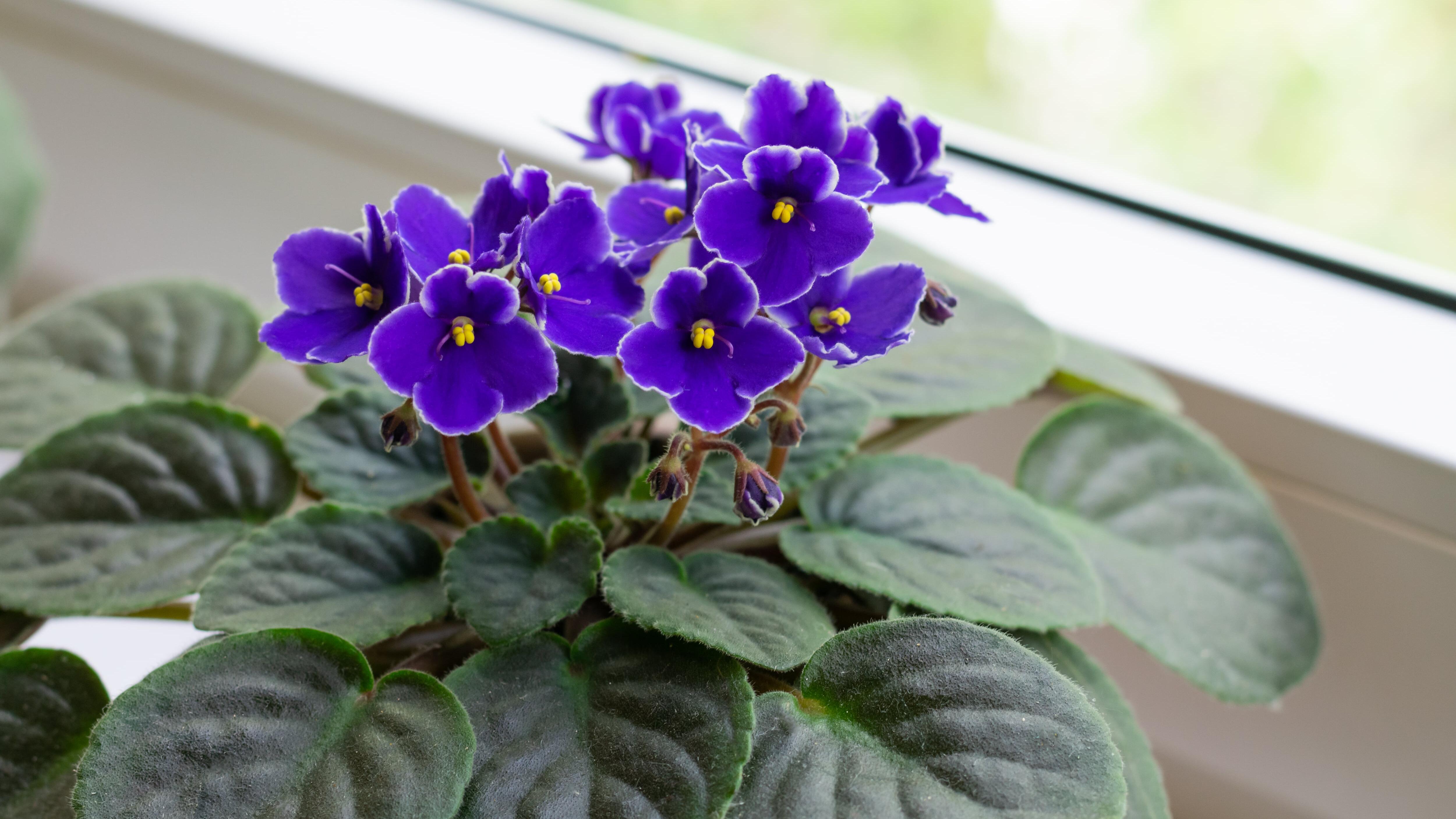
African Violet is a popular houseplant known for its velvety, oval leaves and clusters of very soft flowers in shades of purple, blue, pink, and white.
Native to eastern Africa, it lives in warm, indirect light and consistent humidity, making it perfect for bright bathrooms or kitchens.
Unlike many flowering houseplants, African Violets can bloom year-round when properly cared for.
They prefer well-draining soil specifically formulated for their needs and benefit from careful watering, ideally from the bottom to prevent leaf damage.
These compact plants rarely exceed 6 inches in height, making them ideal for windowsills and small spaces. Their fuzzy leaves and cheerful blooms bring a touch of color to indoor environments with minimal space requirements.
With hundreds of cultivars available, collectors often develop a passion for these charming, low-maintenance flowers.
| Category | Details |
|---|---|
| Scientific Name | Saintpaulia spp. |
| Commonly Found Region | Eastern Africa (Tanzania, Kenya) |
| Blooming Period | Year-round (primarily winter through spring) |
| Symbolism | Faithfulness, love, and loyalty |
| Benefits | Indoor air purifier, low maintenance, attractive blooms |
13. African Daisy
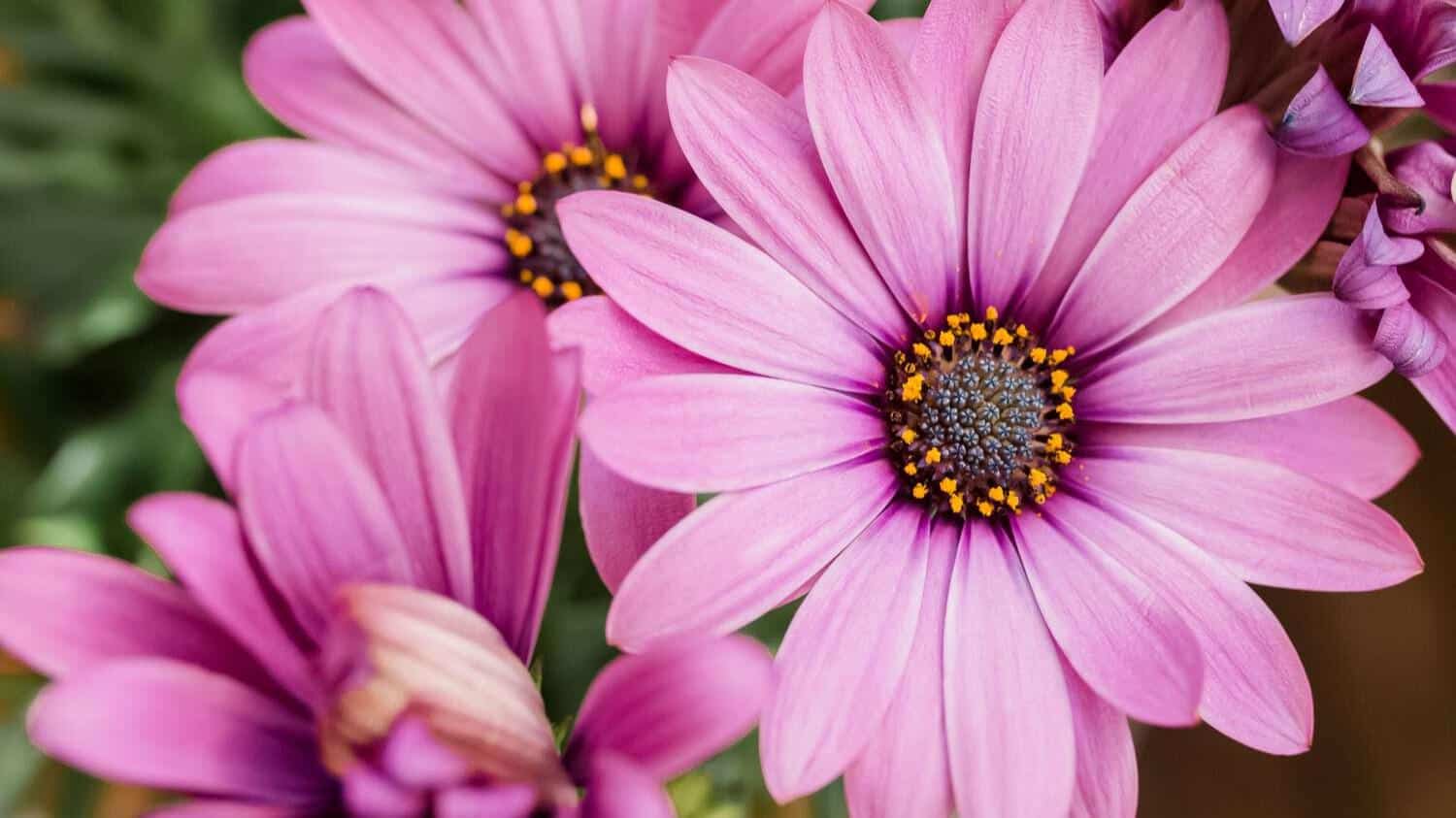
African daisies, also known as osteospermums, are vibrant flowers with daisy-like petals in purples, oranges, whites, and yellows.
They open during sunlight and close at night or in cloudy weather, creating dynamic visual interest.
These drought-tolerant plants live in full sun and are perfect for hot, dry climates. Native to South Africa, African daisies are often used in containers, borders, and xeriscapes.
They are low-maintenance and bloom profusely throughout the summer.
Their unique petal shapes and contrasting centers make them popular among gardeners seeking bold color with minimal effort.
| Category | Details |
|---|---|
| Scientific Name | Osteospermum spp. |
| Commonly Found Region | South Africa |
| Blooming Period | Spring to fall |
| Symbolism | Innocence and purity |
| Benefits | Drought-tolerant, evocative color, low maintenance |
14. Autumn Crocus
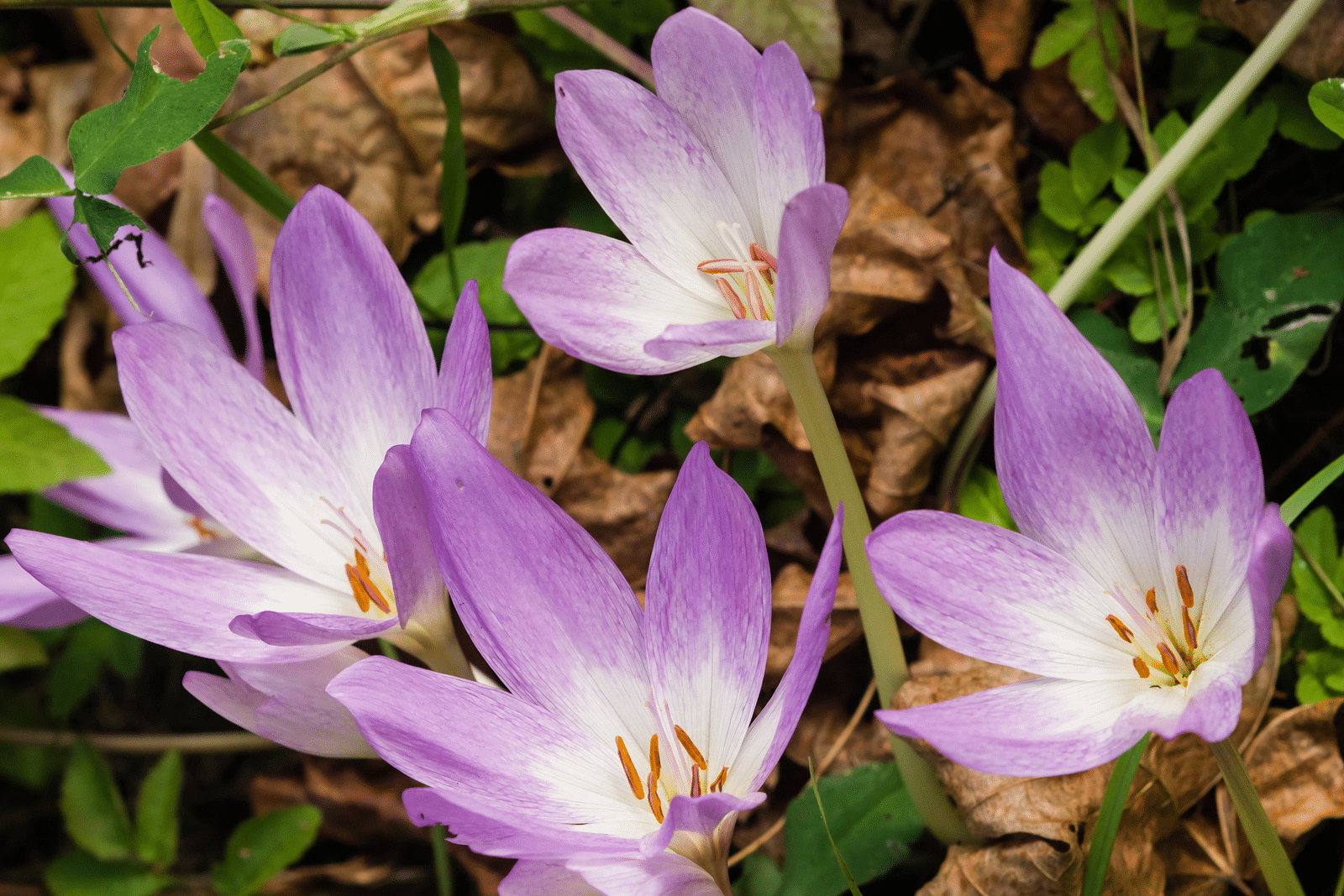
Autumn crocus, or Colchicum, is a fall-blooming flower that resembles spring crocus but belongs to a different plant family.
Its large, chalice-shaped flowers appear in purples and pinks, often emerging without foliage. This surprise blooming habit gives it the nickname “naked lady.” Autumn crocus lives in well-drained soil and sunny to partially shaded areas.
Though beautiful, parts of the plant are toxic if ingested, so care should be taken around pets and children. It’s often used in rock gardens or as a seasonal accent in perennial beds. The bulbs are planted in late summer for autumn blooms.
| Category | Details |
|---|---|
| Scientific Name | Colchicum autumnale |
| Commonly Found Region | Europe, Mediterranean |
| Blooming Period | Fall |
| Symbolism | Surprise, hidden beauty |
| Benefits | Late-season interest, naturalizes well, deer-resistant |
15. Apple Blossom
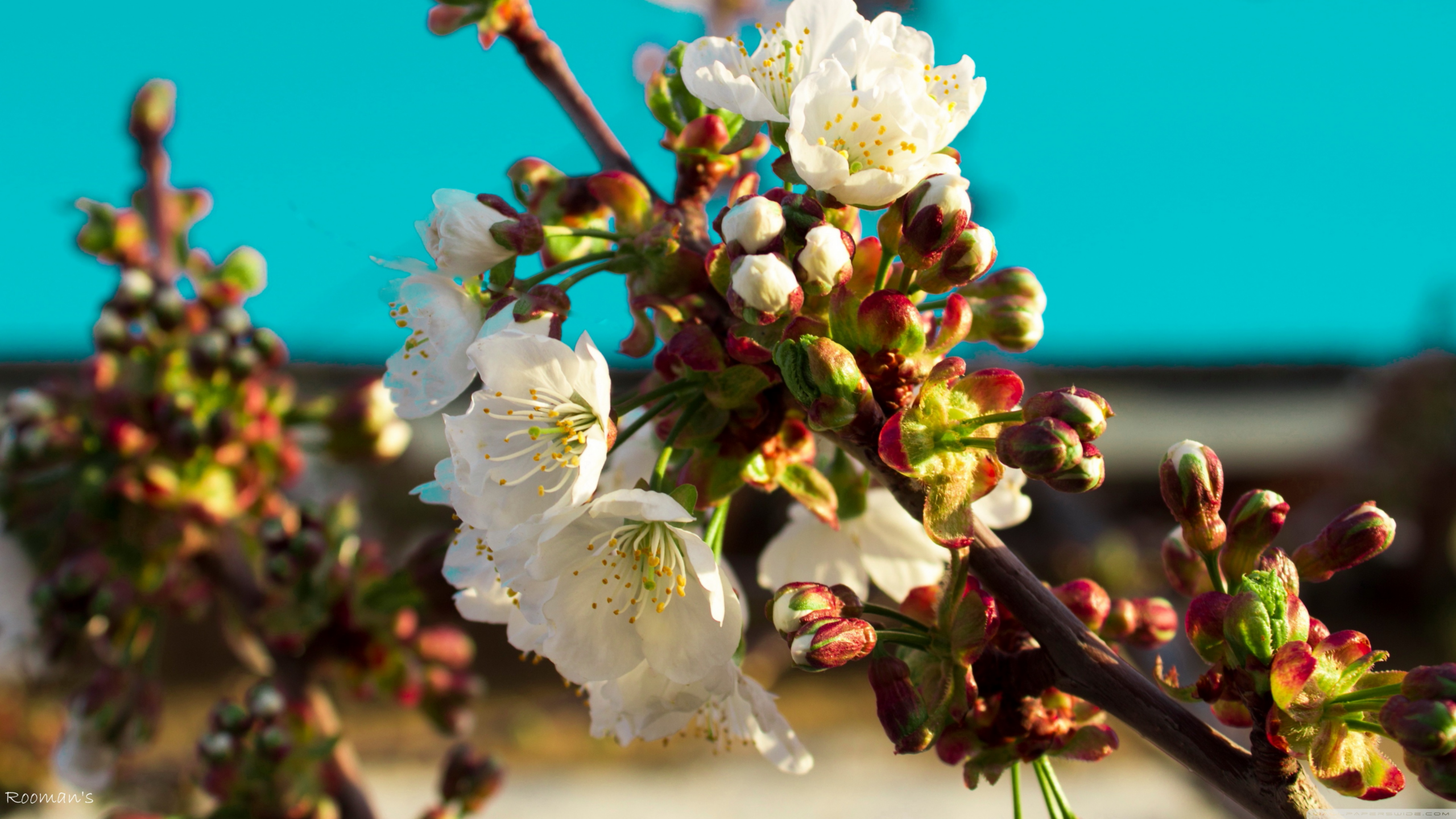
Apple blossoms are the very soft and fragrant flowers of apple trees, blooming in soft shades of pink and white during early spring. These flowers not only mark the start of apple fruiting but also symbolize love, peace, and new beginnings.
Apple blossoms attract bees and are essential for pollination in orchards. They live in temperate climates and require full sun and well-drained soil for optimal growth.
Often featured in bridal bouquets and perfumes, they’re both ornamental and practical. Their beauty makes them a favorite in flowering tree landscapes and spring garden scenes.
| Category | Details |
|---|---|
| Scientific Name | Malus domestica (flower) |
| Commonly Found Region | Temperate regions worldwide |
| Blooming Period | Early spring |
| Symbolism | Love, peace, new beginnings |
| Benefits | Pollination essential, fragrant, ornamental |
16. Astilbe
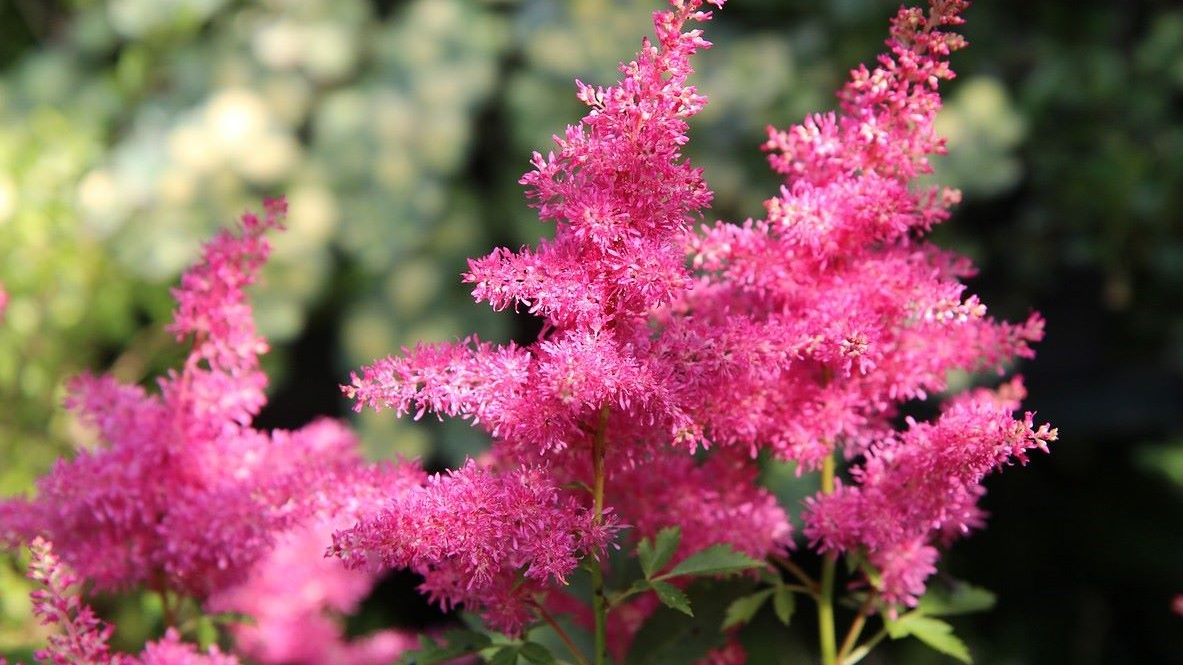
Astilbes are shade-loving perennials known for their feathery plumes of flowers in soft hues like pink, white, red, and lavender.
These blooms rise above fern-like foliage and provide vibrant color to woodland and shade gardens from late spring to midsummer. Astilbes prefer moist, rich soil and perform best with consistent watering, especially during dry spells.
Their foliage remains attractive even after flowering, adding texture and grace to garden beds.
They’re deer-resistant and perfect for borders, water features, or mass plantings.
Dividing every few years helps maintain healthy growth and flower production.
| Category | Details |
|---|---|
| Scientific Name | Astilbe spp. |
| Commonly Found Region | Asia, North America |
| Blooming Period | Late spring to midsummer |
| Symbolism | Patience and dedication |
| Benefits | Shade-tolerant, moisture-loving, attractive foliage |
17. Agapanthus
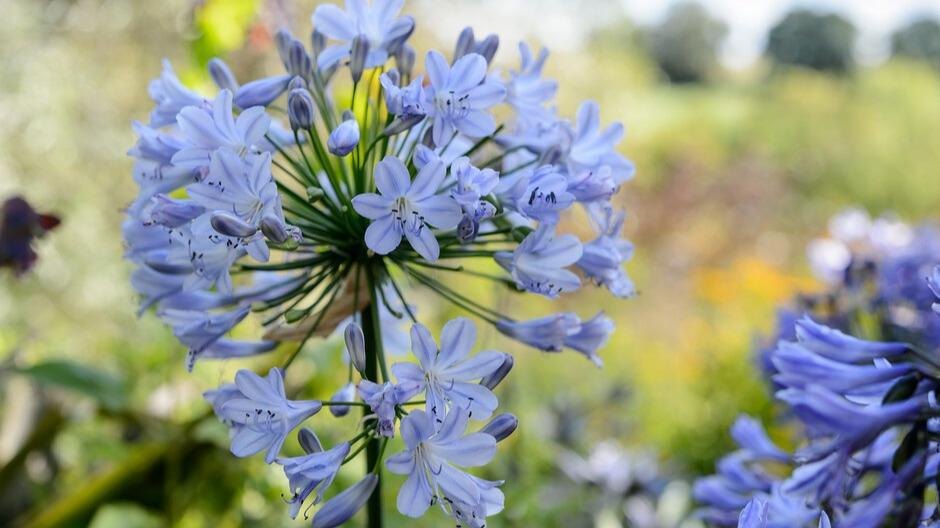
Agapanthus, or lily of the Nile, produces striking blue or white flower clusters atop tall stems, blooming through the summer.
The plant’s strappy leaves provide year-round interest, especially in warmer climates. Agapanthus attracts bees and butterflies and is ideal for borders and containers.
Depending on the region, some varieties are evergreen, while others are deciduous. Once established, it is drought-tolerant, but it benefits from occasional watering during blooming.
| Category | Details |
|---|---|
| Scientific Name | Agapanthus africanus |
| Commonly Found Region | South Africa |
| Blooming Period | Summer |
| Symbolism | Love letters and beauty |
| Benefits | Drought-tolerant, attracts pollinators, striking blooms |
18. Asphodel
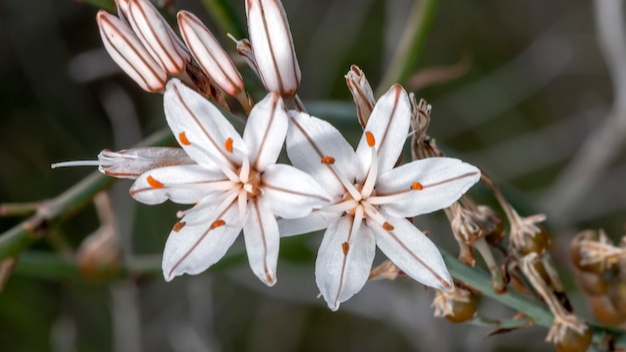
Asphodels are tall, spiky plants with star-shaped flowers, typically in yellow or white, historically linked to mythology and the afterlife. These hardy perennials bloom in late spring or early summer and live in full sun with well-drained soil.
Often used in wildflower meadows and cottage gardens, they lend a limitless beauty to open spaces. Their foliage is grass-like, and the blooms rise on tall stems that sway gently in the breeze.
They’re known for their resilience and minimal maintenance needs. In Greek lore, the asphodel fields were believed to be home to the souls of the dead.
| Category | Details |
|---|---|
| Scientific Name | Asphodelus spp. |
| Commonly Found Region | Mediterranean region |
| Blooming Period | Late spring to early summer |
| Symbolism | Afterlife, remembrance |
| Benefits | Low maintenance, ornamental, attracts bees |
19. Alpine Forget-Me-Not
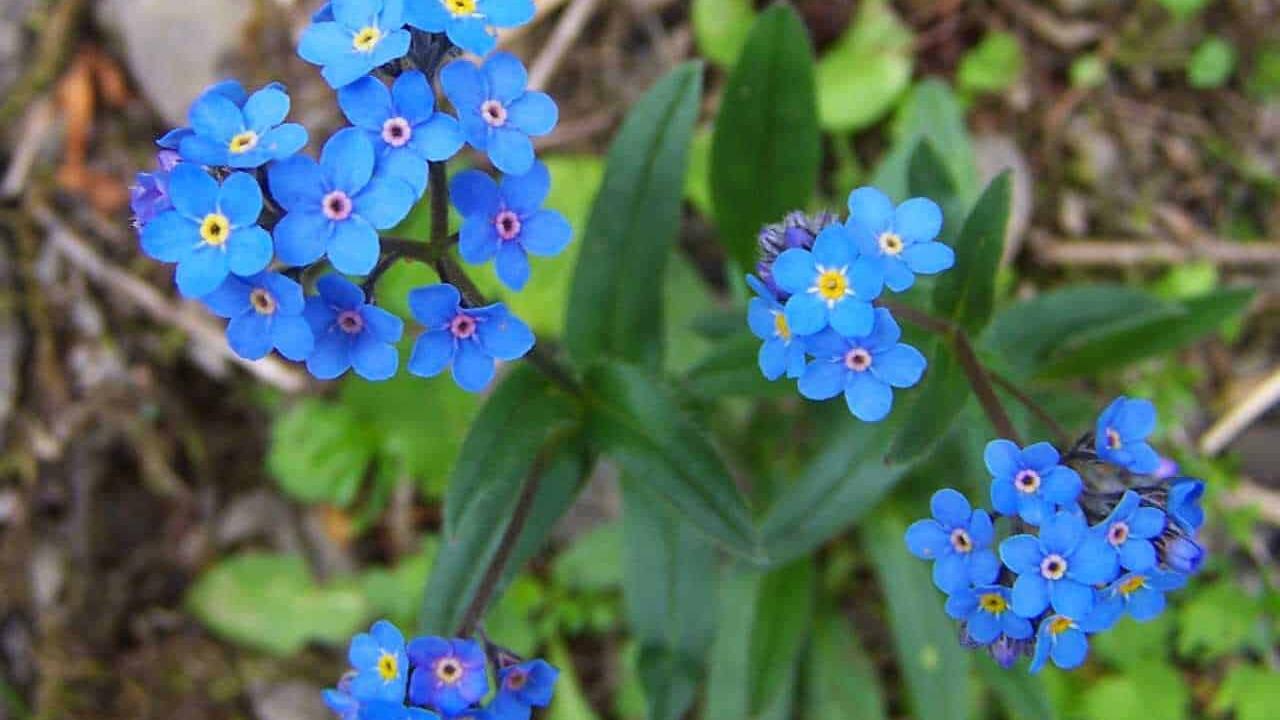
Alpine forget-me-nots are petite blue flowers with yellow centers that bloom in late spring and early summer. These charming perennials live in high-altitude meadows and rock gardens, preferring cool climates and well-drained soil.
The plant forms low-growing clumps, making it excellent for borders and ground cover.
Their very soft appearance belies their toughness in challenging environments. Often associated with remembrance and enduring love, these flowers carry symbolic meaning across cultures.
They require little maintenance and bring a splash of color to shaded garden spots.
| Category | Details |
|---|---|
| Scientific Name | Myosotis alpestris |
| Commonly Found Region | Alpine regions of Europe, Asia |
| Blooming Period | Late spring to early summer |
| Symbolism | Remembrance and true love |
| Benefits | Hardy, low maintenance, evocative ground cover |
Some Other Flowers that Start with A
Beyond the well-known varieties, the botanical world offers a treasure trove of glamorous “A” flowers that deserve recognition in any gardener’s repertoire.
These lesser-known blooms range from hardy perennials to exotic tropical species, each bringing unique textures, colors, and growing habits to gardens and landscapes.
The following collection showcases remarkable plants that might not appear in typical gardening guides but offer exceptional beauty and versatility.
-
Anthericum
-
Amaranthus
-
Angel’s Trumpet
-
Alkanet
-
Aquilegia
-
Acanthus
-
Arctotis
-
Aristolochia
-
Adenium
-
Achillea
-
Aethionema
-
Albizia
-
Andromeda
-
Abelia
-
Armeria
-
Angelica
-
Abutilon
-
Atriplex
-
Asarina
-
Asclepias
-
Aurinia
-
Aeonium
-
Anigozanthos
-
Amsonia
-
Aeschynanthus
-
Aralia
-
Aerva
-
Anemopsis
-
Acaena
-
Argyanthemum
-
Artemisia
-
Antirrhinum
-
Acanthocalycium
-
Adenophora
-
Arisaema
-
Althaea
-
Azorella
-
Anagallis
-
Asparagus Fern
-
Amicia
-
Ajuga
-
Abronia
-
Alysicarpus
-
Asteriscus
-
Aspidistra
-
Aulax
-
Aegopodium
-
Arnebia
Tips for Caring for Your Flowers
The art of nurturing flowers extends far beyond the simple act of watering. Creating an environment where blooms can live requires understanding the delicate balance of light, moisture, nutrients, and care that each variety demands.
This practical tips is applied to most flowering species, providing a foundation for successful cultivation regardless of your experience level.
- Water most flowers deeply but infrequently, allowing the soil to dry slightly between waterings to prevent root rot.
- Apply fertilizer according to each plant’s specific needs, typically monthly during growing seasons, with a balanced formula.
- Deadhead spent blooms regularly to encourage continued flowering and prevent plants from wasting energy on seed production.
- To conserve moisture, suppress weeds, and regulate soil temperature, mulch around plants with 2-3 inches of organic material.
- Inspect plants weekly for pests like aphids, spider mites, or mealybugs, treating infestations early with appropriate methods.
- Provide adequate spacing between plants to ensure proper air circulation, which helps prevent fungal diseases.
- Stake tall or top-heavy flowers before they begin to lean or fall over, using materials that won’t damage stems.
- Divide overcrowded perennials every 3-5 years to maintain vigor and flowering capacity.
- Protect sensitive flowers from extreme weather with covers, windbreaks, or temporary shelters as needed.
- Prune appropriately for each species—some benefit from hard cutbacks while others need only minor trimming.
- Adjust watering schedules seasonally, providing more moisture during hot, dry periods and less during cooler months.
- Test soil pH every 1-2 years and amend accordingly, as most flowers prefer slightly acidic to neutral conditions.
- Apply compost annually to replenish nutrients and improve soil structure around established plantings.
Wrapping It Up
From the structural Acanthus to the very soft Anthericum, these flowering plants offer infinite possibilities for every garden environment.
It doesn’t matter if you’re looking to attract pollinators, create drought-resistant landscapes, or add vibrant color to your space; this list of flowers that start with A demonstrates nature’s remarkable diversity.
As you consider your next planting project, remember that many of these species live in challenging conditions: poor soil, drought, shade, making them excellent choices for sustainable gardening.
By incorporating these unique blooms into your landscape, you’re not just creating beauty but also supporting local ecosystems and wildlife.
The world of flowers extends far beyond familiar favorites. We hope this guide inspires you to find these botanical treasures and uncover the perfect “A” plants for your garden’s personality.





